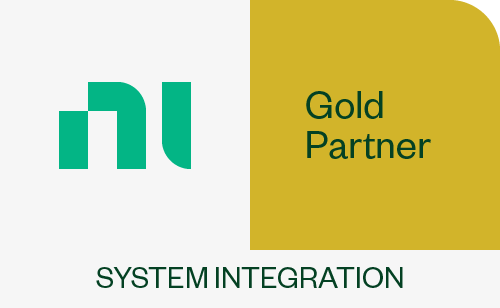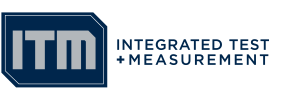Test Cell Vibration Monitoring
A large-engine manufacturer had test cells with severe vibration levels…
The Blog Post category contains blog posts associated with ITM’s testing services, LabVIEW programming, Test & Measurement Hardware, Boiler Monitoring Systems, and iTestSystem applications.
A large-engine manufacturer had test cells with severe vibration levels…
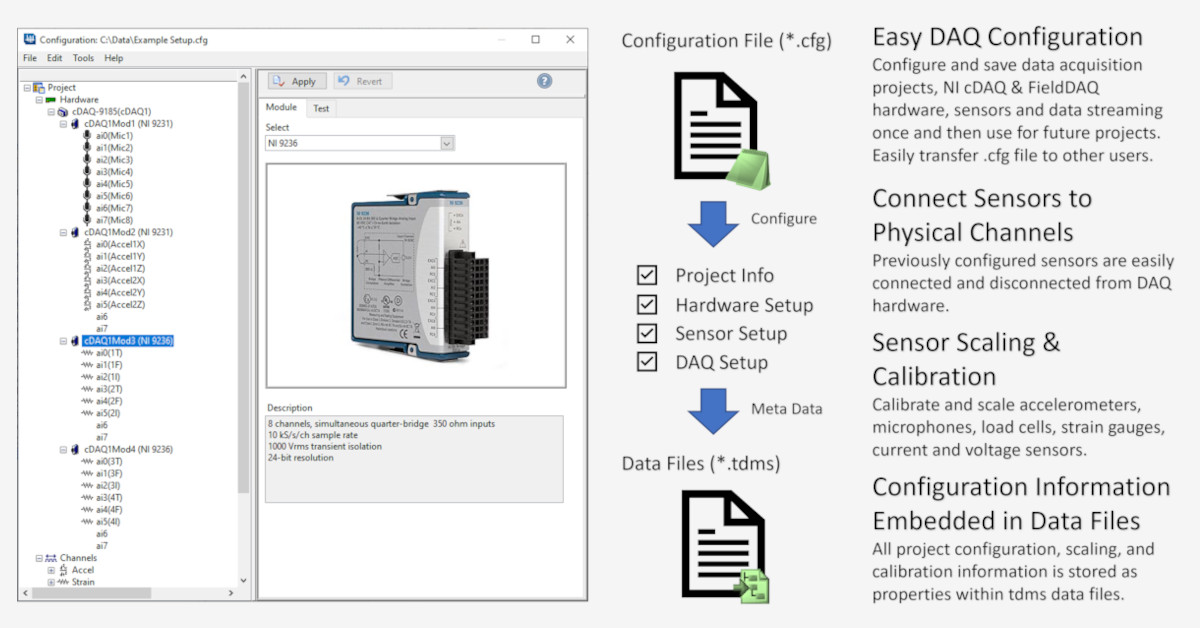
Turn Weeks Into Hours with iTestSystem’s Configuration Feature
If you are like most engineers, the last thing you want to do is spend hours upon hours configuring your project, your hardware and your sensors before gathering important data.
The team at Integrated Test & Measurement (ITM) has been there. In fact, they grew so tired of repeating all those monotonous configurations when setting up NI cDAQ and NI FieldDAQ hardware that they built their own custom software known as iTestSystem to simplify the experience.
In this blog, a new series by ITM, we’ll share details about Configuration, the core feature of iTestSystem and a driving reason their software engineers first dreamed it up clear back in 2007.
Imagine opening a single screen to set up your entire test — from the hardware you are using to all the sensors you are employing to how you are planning to take the data. With iTestSystem’s Configuration feature these things are not only possible, they are reusable. In other words, you set up your hardware and configure your channels once, and all future applications can reuse the same setup.
iTestSystem users are used to heading to the Configuration screen not just to set up their MultiDAQ tests but also to calibrate, zero and test their sensors to be sure everything is working and connected correctly prior to going into a test. It is also a simple way to preview all your channels.
Managing tests has never been easier, even when taking thousands of channels of data. You can even save and share your test setup with others. And, best of all, iTestSystem is a free download, so anyone can take advantage of the massive time savings — turning weeks of work into hours of work.
About iTestSystem
iTestSystem is an engineering measurement software platform that enables test engineers to organize, acquire, view, and analyze data from machinery, processes, vehicles and other complex systems. iTestSystem was specifically designed for use with NI cDAQ or FieldDAQ hardware for data collection and data logging.
For more information about our iTestSystem or ITM’s testing services, contact Ryan Welker @ (844) 837-8797 x702.
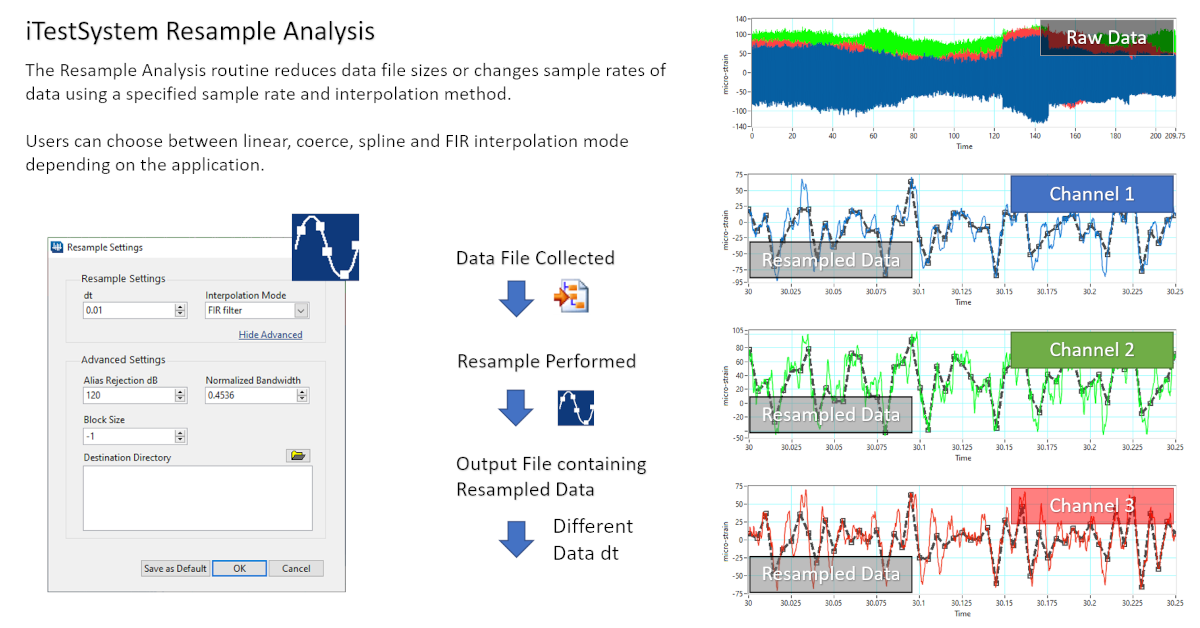
Going Small Can Yield Big Results Thanks to Resample Analysis Feature
While it may seem counterintuitive to those used to gathering massive data files to solve complex engineering challenges, certain situations actually require gathering smaller files if you want to run a successful test.
For example, certain tests require gathering data on remote machinery over multiple months. In that instance, the onboard hard drive that’s storing the data will simply run out of space if you are gathering data at a high sample rate.
The team at Integrated Test and Measurement anticipated such needs. In this blog, a new series by ITM, we’ll share some details about Resample Analysis, one of the features within TestView Plus, the project based data viewing function within iTestSystem.
Though simple, the Resample Analysis function allows you to perform a powerful function — to greatly reduce file sizes while maintaining an accurate picture of the information gathered. With one click, raw files that were saving at 20 MB and larger are reduced to less than 1 MB, yet your engineers will still be able to capture an accurate picture of the test.
The process is easy. Open TestView Plus, add a channel, plot some data and click the Resample feature, just remember to also use the Filtering feature to avoid aliasing your data. Though you are sacrificing frequency content, you are gaining data storage, and the data will still tell you the big picture of what’s happening.
About iTestSystem
iTestSystem is an engineering measurement software platform that enables test engineers to organize, acquire, view, and analyze data from machinery, processes, vehicles and other complex systems. iTestSystem was specifically designed for use with National Instruments (NI) cDAQ or FieldDAQ hardware for data collection and data logging.
For more information about our iTestSystem or ITM’s testing services, contact Ryan Welker @ (844) 837-8797 x702.
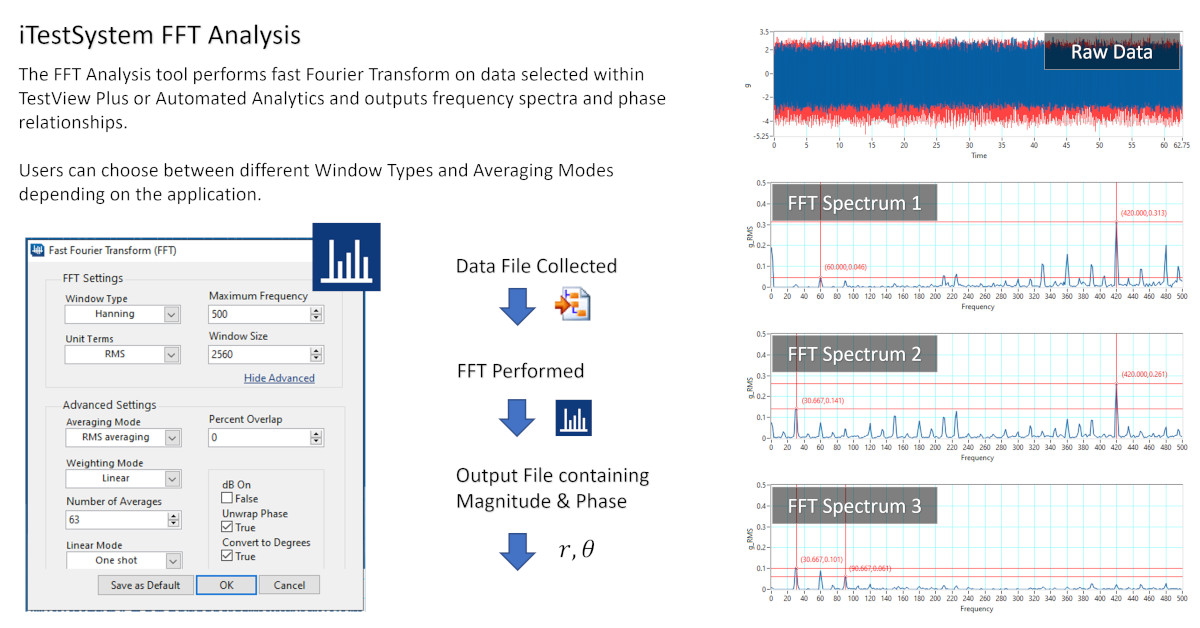
Simplifying Process for FFT Analysis using iTestSystem to Pinpoint Vibration Issues
The software engineers at Integrate Test & Measurement are constantly looking for ways to enhance and simplify your experience using iTestSystem, their proprietary engineering measurement software platform.
In this blog, a new series by ITM, we’ll share some details about one of the features within TestView Plus, the project based data viewing function within iTestSystem.
Are you one who tires of gathering vibration data in one tool then having to port it over to a whole separate tool to analyze the signal data? Thanks to plugin functionality in the latest version of iTestSystem, you can now manage both functions all from the same screen.
Once you’ve configured your test using NI MultiDAQ hardware and begun logging strain gauge and accelerometer data, it is time to do FFT (fast Fourier transform) Analysis to further analyze your signals for frequency information to learn how the system you are testing is actually vibrating. Without leaving TestView Plus, you can simply choose which signals you wish to view, configure a few options on the screen and click the convenient FFT button to output helpful data files for your report or plot directly within TestView Plus to begin isolating specific vibration issues.
Stay tuned for additional iTestSystem features, including a plugin that allows Filter Analysis to quickly weed out unwanted frequencies.
About iTestSystem
iTestSystem is an engineering measurement software platform that enables test engineers to organize, acquire, view, and analyze data from machinery, processes, vehicles and other complex systems. iTestSystem was specifically designed for use with National Instruments (NI) cDAQ or FieldDAQ hardware for data collection and data logging.
For more information about our iTestSystem or ITM’s testing services, contact Ryan Welker @ (844) 837-8797 x702.
Check out this awesome video that describes how our testing services group provides engineering measurement solutions to our customers around the world. We’ve been at it for twenty (20) years today!
For more information about out strain gauging and testing services, contact Ryan Welker at (844) 837-8797 x702.
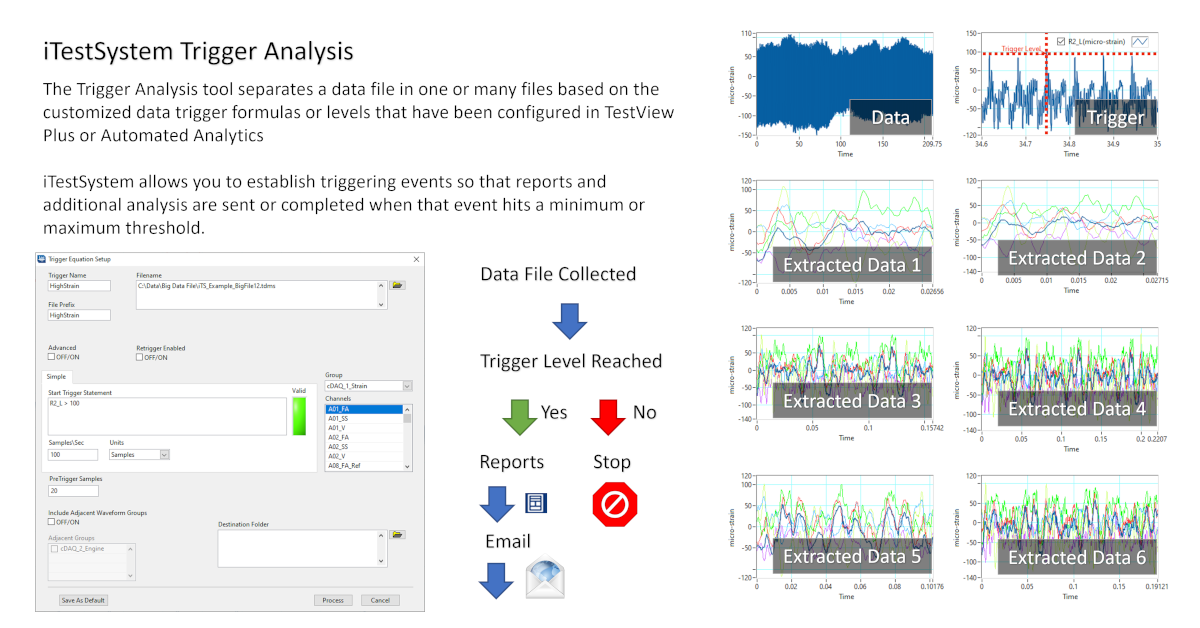
Sort Your Engineering Data Faster Using iTestSystem’s Trigger Analysis Feature
Tired of getting buried in a mountain of engineering data? The team at Integrated Test & Measurement feels your pain, and they have built some relief into their data collection software known as iTestSystem.
In this blog, a new series by ITM, we’ll share details about iTestSystem’s “Trigger Analysis” feature, which is commonly used to help analyze, sort and pass crucial engineering data — think strain and vibration — to those who need it most and just in time.
The Trigger Analysis tool separates a data file in one or many files based on the customized data trigger(s) that have been configured, and that’s a feature that saves engineers countless hours.
Here’s how Trigger Analysis works:
If you are an engineer attempting to gather data from a piece of machinery, vehicle or complex system, iTestSystem allows you to establish triggering events so that reports are only sent when that event hits a minimum or maximum threshold. For example, if you know a damaging event occurs at a certain threshold, you can easily set iTestSystem to only report information or graphs to you when an accelerometer goes over a maximum level or when an engine passes a set RPM.
In other words, the software is gathering data constantly, but it only sends the data when it matches a specific threshold.
By configuring Trigger Analysis along with both Notification Services and the Automated Analytics features in iTestSystem, engineers are able to greatly simplify processes that require hunting down system operation outliers or damaging events. These iTestSystem applications allow users to analyze, build, and send sensor level reports only when specific vibration and strain limits are exceeded. In the end, that leads to a massive time savings. Instead of searching through streams of data files, engineers can easily review the report and download relevant data files from deployed systems for further analysis.
About iTestSystem
iTestSystem is an engineering measurement software platform that enables test engineers to organize, acquire, view, and analyze data from machinery, processes, vehicles and other complex systems. iTestSystem was specifically designed for use with National Instruments (NI) cDAQ hardware for data collection and data logging.
For more information about our iTestSystem or ITM’s testing services, contact Ryan Welker @ (844) 837-8797 x702.
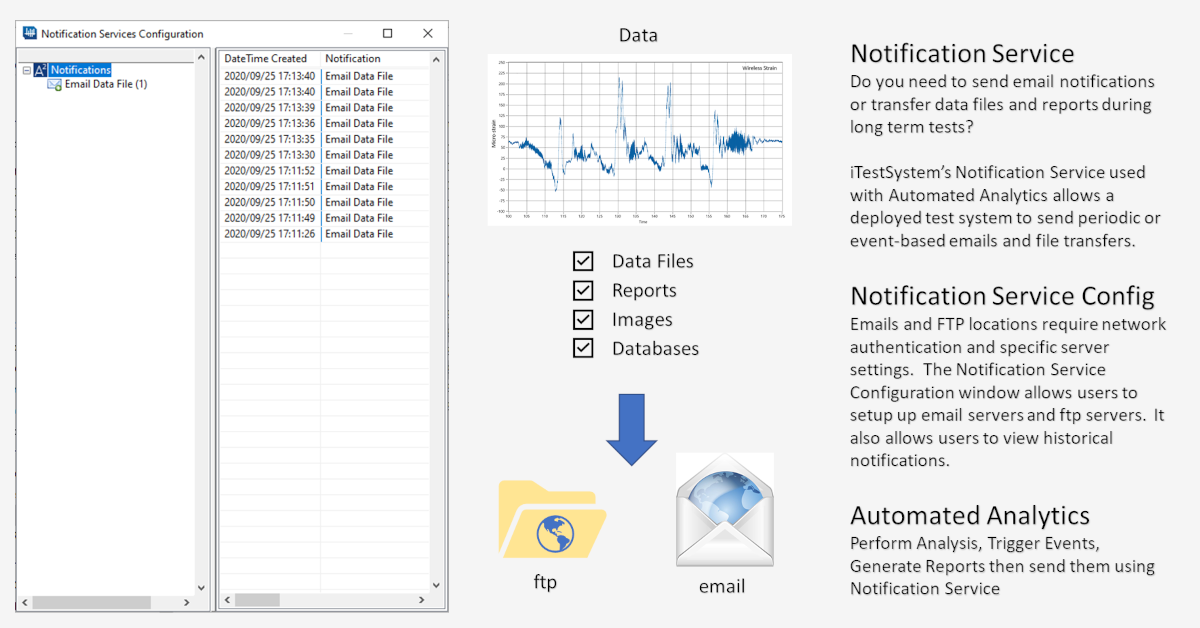
Get Your Engineering Data When it Counts using ITM’s iTestSystem Software
In a world where we’ve grown accustomed to knowing about important events or crucial information nearly immediately, it may be of little surprise that the architects who build engineering measurement software included powerful notification abilities.
An Amazon package delivery to your doorstep now prompts an email, a text or even a blinking light on your Alexa or Google Assistant.
At Integrated Test & Measurement, the engineers behind iTestSystem applied this need-to-know concept to the latest version of their powerful and proprietary data-collection tool. In this blog, a new series by ITM, we’ll share details about iTestSystem’s “Notification Services” feature, which is commonly used to to pass crucial engineering data — think strain and vibration — to those who need it most and just in time.
By pairing Notification Services with the Automated Analytics feature in iTestSystem, engineers are able to greatly simplify processes that require hunting down system operation outliers or damaging events. The Automated Analytics application allows users to analyze, build, and send sensor level reports only when specific vibration and strain limits are exceeded. In the end, that leads to a massive time savings. Instead of searching through streams of data files, engineers can easily review the report and download relevant data files from deployed systems for further analysis.
Does your project involve the need to deploy unattended or “black box” data acquisition systems in the field? If so, iTestSystem may be the ideal solution.
Here’s how Notification Services works:
As mentioned above, users can pair the Automated Analytics feature with the power of Notification Services, an iTestSystem feature that allows reports — including helpful graphs — to be automatically sent to them daily, weekly or whenever most useful. This feature is especially beneficial if engineers do not have access to the equipment being monitored.
Once you’ve configured your cDAQ hardware, project path and sensor channels in iTestSystem, set up your MultiDAQ and record a sample TDMS file. Then simply open Automated Analytics to set up and run a new automation. After that’s complete, configure Notifications Services on the schedule of your liking.
Rather than getting buried in a mountain of raw data files that require processing later, users can easily set up an automated routine using iTestSystem’s Automated Analytics feature and configure Notification Services to dispatch regular reports or only ping over when a system achieves any of countless thresholds.
About iTestSystem
iTestSystem is an engineering measurement software platform that enables test engineers to organize, acquire, view, and analyze data from machinery, processes, vehicles and other complex systems. iTestSystem was specifically designed for use with National Instruments (NI) cDAQ hardware for data collection and data logging.
For more information about our iTestSystem or ITM’s testing services, contact Ryan Welker @ (844) 837-8797 x702.
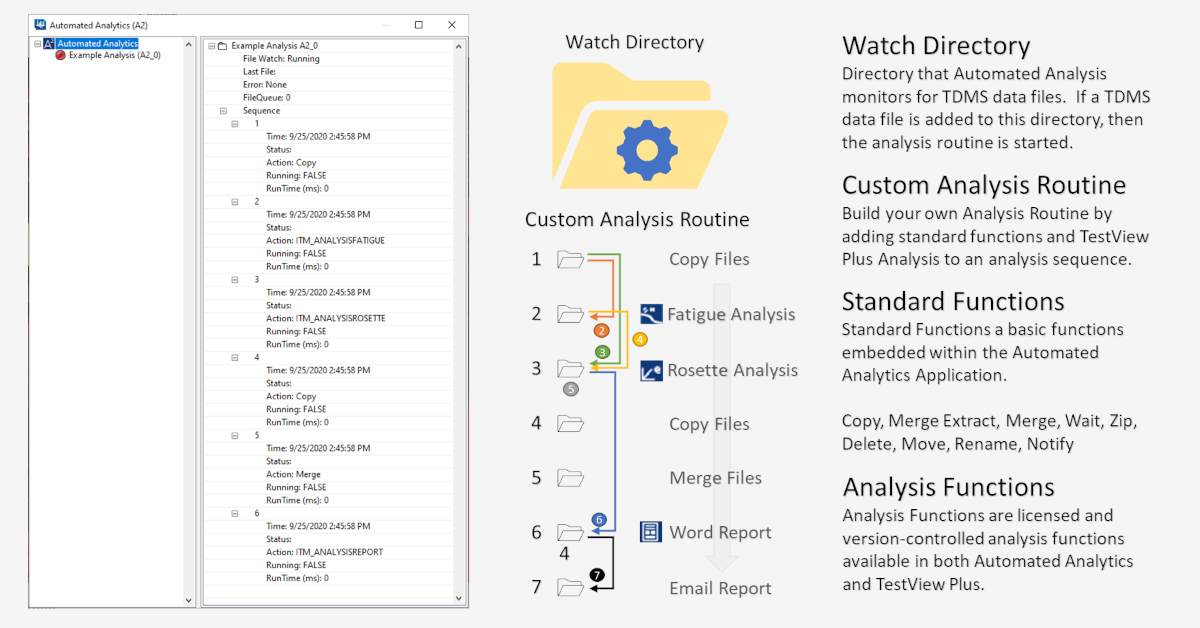
Does your project involve the need to deploy unattended or “black box” data acquisition systems in the field? If so, our engineering software known as iTestSystem, a proprietary product developed by Integrated Test & Measurement, may be the ideal solution.
In this blog, a new series by ITM, we’ll share details about iTestSystem’s “Automated Analytics” feature, which is commonly used to to constantly analyze strain and vibration data on machinery, vehicles and industrial processes.
By using the Automated Analytics feature in iTestSystem, engineers are able to greatly simplify processes that require hunting down system operation outliers or damaging events. The Automated Analytics application allows users to analyze, build, and send sensor level reports only when specific vibration and strain limits are exceeded. In the end, that leads to a massive time savings. Instead of searching through streams of data files, engineers can easily review the report and download relevant data files from deployed systems for further analysis.
Here’s how Automated Analytics works:
Rather than getting buried in a mountain of raw data files that require processing later, users can easily set up an automated routine using iTestSystem’s Automated Analytics — just one feature among the many analysis applications built into the latest version of this powerful tool.
Once you’ve configured your cDAQ hardware, project path and sensor channels in iTestSystem, set up your MultiDAQ and record a sample TDMS file. Then simply open Automated Analytics to set up and run a new automation.
Users assign a “Watch Directory,” and any TDMS files they pull into that directory will have the automated sequence of events they chose applied to those files automatically. Simply click into the properties for any file to reveal the newly embedded statistics or analysis data within.
Users can pair the Automated Analytics feature with the power of Notification Services, an iTestSystem feature that allows reports — including helpful graphs — to be automatically sent to them daily, weekly or whenever most useful. This feature is especially beneficial if engineers do not have access to the equipment being monitored.
Stay tuned for additional iTestSystem features, including the ability to set up Trigger Analysis events so reports are only dispatched when the data reaches a certain threshold.
About iTestSystem
iTestSystem is an engineering measurement software platform that enables test engineers to organize, acquire, view, and analyze data from machinery, processes, vehicles and other complex systems. iTestSystem was specifically designed for use with National Instruments (NI) cDAQ hardware for data collection and data logging.
For more information about our iTestSystem or ITM’s testing services, contact Ryan Welker @ (844) 837-8797 x702.

ITM’s Resilience Recognized with County’s ‘Excellence in Impact Award’
Like most small businesses, Integrated Test & Measurement spent the last year weathering a storm of uncertainty due to COVID-19. How would the company both stay safe and stay in business?
The answer to that crucial question and the actions that ITM took during the pandemic were recognized on Feb. 12 when the Milford, Ohio, engineering firm was named the winner of the Excellence in Impact Award by The Ohio Small Business Development Center at the Clermont Chamber of Commerce, presented by Duke Energy.
 The Excellence in Impact Award is given annually to one Clermont County business that demonstrates an outstanding contribution to the local economy, and ITM President Tim Carlier was thrilled to have his company recognized, particularly after the challenging year his team has endured.
The Excellence in Impact Award is given annually to one Clermont County business that demonstrates an outstanding contribution to the local economy, and ITM President Tim Carlier was thrilled to have his company recognized, particularly after the challenging year his team has endured.
As the pandemic pressed its way into Ohio and the governor declared a stay-at-home order in March of 2020, ITM faced a series of massive challenges. The company relies heavily on travel and on-site work to complete complex testing and analysis in industries such as aerospace as well as pulp and paper. The year 2020 was supposed to be a year for growth, yet the pandemic threatened their entire business model.
Major clients who had been defined as “critical infrastructure” industries by the Department of Homeland Security were reaching out to see if ITM intended to meet its obligations. Rather than withdrawing and playing it safe, Carlier challenged his team to lean in, learn all they could, then do the work as they always had. He knew their success would depend on their resiliency.
“While this COVID 19 virus is complicated, my position is simple,” he said in an email to the team. “ I am working hard to keep everyone safe by mitigating employees’ risk for exposure and staying in business. I cannot do this alone, I need your help.”
They took an engineer’s approach to the virus and developed an exhaustive document titled “ITM COVID-19 Operating Response Guidelines.” They learned they could work from a distance effectively when needed using Microsoft Teams. After a short lapse, travel was back on, but they would need to be more creative. Long car rides replaced flights, and teams even broke into multiple vehicles to assure safety. They scoured local stores for masks, paper towels and sanitizer and found themselves grateful when boxes of basic supplies arrived from both the state and Clermont Chamber of Commerce.
Ultimately ITM kept its obligations to its clients, and was even able to continue on a growth trajectory in 2020 thanks in part to the Paycheck Protection Program (PPP). In fact, the team of 7 actually added a full-time position and two co-op students, plus they doubled down on marketing efforts, which is now leading to even more opportunities in 2021. Carlier is incredibly thankful that the team went above and beyond to deliver during the pandemic, and he points out that along the way they learned a great deal about themselves and realized when tested, they can, in fact, emerge stronger.

More About ITM
ITM is a structural test & measurement engineering service and software company that focuses on three vertical spaces: Industrial monitoring, testing services, and its proprietary test software iTestSystem. ITM was founded by Tim Carlier in 2001 to help companies reduce costs and improve efficiencies in their product development, manufacturing, and production activities. ITM provides software development, structural and mechanical testing services, industrial monitoring, strain gauge (gage) installations, and data analysis solutions to clients on five continents.
Of specific note is ITM’s work with NASA and the aerospace industry as well as the firm’s patented technology in boiler monitoring systems. These advances and specifically ITM’s Sootblower Fouling Detection System (FDS) allow for substantial efficiencies inside black liquor recovery boilers where operators are now able to conserve as much as 5% of a boiler’s total steam. Not only does this advance in boiler efficiency carry an enormous environmental impact by reducing carbon emissions, but the value of steam savings can also exceed more than a million dollars a year at plants where it is adopted.
Link: Clermont Chamber of Commerce News Release

ITM SFD technology helps energy producers generate power more efficiently by detecting energy sapping soot buildup in power and recovery boilers
According to the U.S. Department of Energy, the pulp and paper industry is the 3rd largest consumer of energy in U.S. manufacturing. A great deal of that energy is expended to generate massive amounts of steam inside about 200 black liquor recovery boilers spread around North America. That steam then powers generators that produce electricity to operate the mills.
Imagine the energy savings if enhancements inside those recovery boilers could conserve 5% of all that steam. Not only would this advance in boiler efficiency carry an enormous environmental impact — potentially trillions of BTUs — the value of that steam savings would equal more than a million dollars a year at every plant where it is adopted.
Figures like these help explain why Tim Carlier has spent years refining the novel idea he calls the Sootblower Fouling Detection System or SFD. SFD is his patented technology for measuring fouling/slagging as well as sootblower performance and reliability in recovery, biomass and utility boilers.
In a typical boiler, fuel is burned inside the furnace, creating hot gas which heats water in the steam-generating tubes. In the case where the fuel is biomass, the flue gas often contains a significant amount of carry-over, which collects on the boiler tubes causing buildup. This buildup, also known as fouling, decreases the efficiency of the heat being transferred to generate steam while also increasing the risk of plugging the boiler and taking it offline altogether.
For decades, these industries have relied on sootblowers — long rotating lances that are inserted through the superheater and other steam-generating tubes during combustion — to blow off soot and dislodge the masses of ash deposits that form around steam-generating tubes. Rather than running sootblowing systems “blind,” the SFD System removes guesswork by pinpointing exactly when and where sootblowing is required.
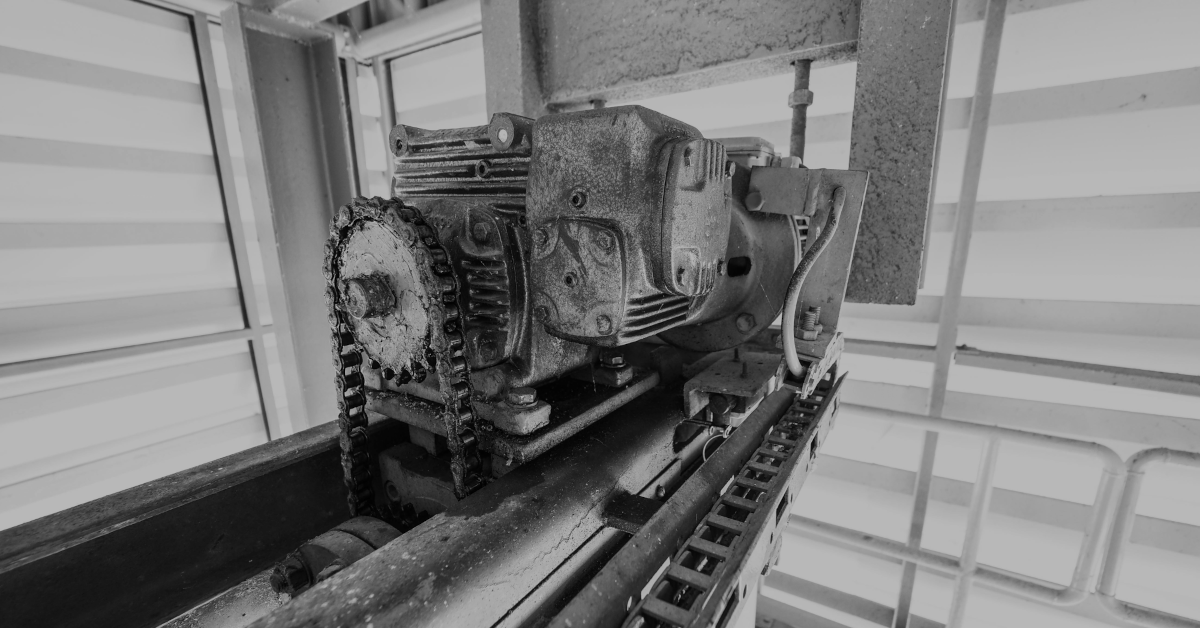
The system relies on a series of sensors on the sootblowers as well as at key locations on the boiler system that allow it to measure the energy transfer to indicate how much buildup is present so that sootblowing is only applied when needed. The feedback mechanisms can inform the plant operator not just where to run sootblowers, but also if sootblowers are leaking steam or malfunctioning in other ways.
“This technology could have a huge environmental effect,” says Carlier, president and founder of Integrated Test and Measurement, the Milford, Ohio, engineering service and software company. “You are getting that much more efficiency out of your boiler, so not only are you saving money because you are not wasting steam, but you are not having to burn as much fuel to generate as much electricity.”
He estimates that recovery boilers at most pulp and paper mills generate between $20 million and $40 million a year in steam depending on their Maximum Continuous Rating (MCR), and roughly 10% of the steam goes toward soot blowing operations. Carlier estimates that SFD could enable operators to decrease their sootblowing between 25% and 50% leading to a savings between $500,000 and $2 million dollars a year.
In addition to the significant steam savings, SFD will also greatly enhance the reliability of sootblowing operations by answering crucial questions for operators: What’s the condition of the sootblower motor and gearbox? Is the poppet valve stuck open, stuck closed, and leaking, or is it operating correctly? Is the track damaged? Is the sootblower lance bent? Is the sootblower stuck in the boiler? What condition is the sootblower packing? Are there any steam leaks on or near the sootblower? Keeping informed on these important questions ultimately helps avoid costly downtime and even schedule crucial maintenance.
On its own, the removal of sootblowing guesswork will generate a quick return on investment, Carlier says. When all is said and done, power generation facilities can expect to see a return on investment from the SFD System in approximately six months to a year.
For more information about Sootblower Fouling Detection Systems or ITM’s other industrial boiler monitoring solutions, contact Ryan Welker via email: ryan.welker@itestsystem.com or phone: (844) 837-8797 x 702
ITM | Integrated Test + Measurement
227 Water Street, Suite 300
Milford, OH 45150
Phone: 1.844.TestSys
Fax: 513.248.8453
Email: ITM Sales
ITM provides software development, structural and mechanical testing services, industrial monitoring, strain gauging, and data analysis solutions to clients on six continents. ITM is a recognized National Instruments Gold Alliance Partner.
